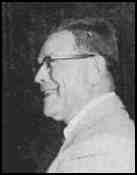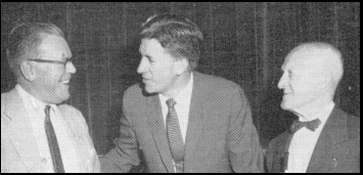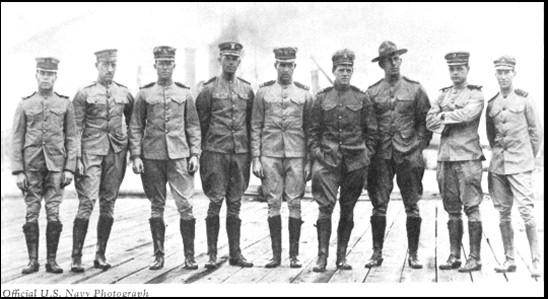
1885-1962 |
 |
 |
|
PIONEERS OF FLIGHT --- Vice Admiral Patrick N. L. Bellinger, USN (Ret.), left and
Major Gen. Benjamin D. Foulois, USAF (Ret), right,
relive some of their early adventures in aviation with FAA Administrator Najeeb E. Halaby, center. Occasion was a dinner, given June 15,
1961, by the District of Columbia Wing OX-5 Club of America in honor of the two aviation pioneers, Admiral Bellinger, 76, was in command
of the famous NC-1 during the Navy's first Trans-Atlantic flight in 1919. General Foulois, 81, made his first flight in 1909 with Orville Wright
at Fort Meyer, Va., and was Chief of the Army Air Corps when he retired in 1935 --- U. S. Air Force Photo. November, 1961, Number 67 |
 |
|
Camp personnel, circa January-March 1913, during Naval aviation's first fleet "deployment". Officers present are (left-to-right): Lieutenant(Junior Grade) Patrick N.L. Bellinger, USN; First Lieutenant Bernard L. Smith, USMC; First Lieutenant Alfred A. Cunningham, USMC; Lieutenant John H. Towers, USN; Ensign Victor D. Herbster, USN; Ensign William D. Billingsley, USN; Ensign Godfrey deC. Chevalier, USN. Note goat and dog mascots and canvas hangar with a Curtiss "A" type airplane inside. Collection of CommanderTheodore G. Ellyson. U.S. Naval Historical Center Photograph. |
|
|
 |
|
By March of 1914 the U.S. Navy had established a flying school at Pensacola, Florida. Among the commissioned officers taking the
course that year were the above (left to right); Lieutenant V. D. Herbster,
Lieutenant W. M. McIlvain, Lieutenant P. N. L. Bellinger,
Lieutenant R. C. Saufley, Lieutenant J. H. Towers,
Lieutenant Commander H. C. Mustin, Lieutenant (Army) B. L. Smith,
Ensign de Chevalier, and Ensign M. L. Stolz. from The Early Birds by Arch Whitehouse |
|
You will find a nice picture of Lt. Bellinger flying a U. S. Navy Flying Boat at Vera Cruz on the Air Mail Pioneer site. You can access the page by clicking on: P. N. L. Bellinger I heartily recommend that you browse the whole site by clicking on: Air Mail Pioneers |
|
ON THE AEROFILES WEBSITE You will find a delightful anecdote by Patrick on the AEROFILES website. It is one of a collection of remembrances which come from the July 1953 Aero Digest You can visit his story, and several other EB's by clicking on: Patrick Bellinger and using the "Find" function on "Bellinger" Plan to spend some time on this wonderful site. |
|
(By Paul E. Garber) Known to most of us as "Pat", and admired by all for his sterling qualities as a man and an officer, Patrick Nelson Lynch Bellinger passed away May 29, 1962 in Clifton Forge, Virginia, after a brief illness. Born at Cheraw, S. C., in 1885, Admiral Bellinger graduated from the Naval Academy in 1907, and like his fellow aviation enthusiasts Ted Ellyson (EB) and Ken Whiting, (EB) went first into submarines but soon transferred to aviation. In 1914, during the operations at Vera Cruz, Mexico, when Pat was piloting a Curtiss flying boat in reconnaissance, he was fired upon, becoming the first American to encounter enemy fire in an airplane. For his heroism, he was recommended for the Medal of Honor. He set a seaplane altitude record of 6200 feet, June 13, 1913, in a Curtiss; and April 223, 1915, climbed a Burgess Dunne to 10,000 feet in one hour, 19 minutes. As Naval Air Pilot No. 4, he participated in early catapult launchings, night flying, directed Naval mortar fire from the air, made armed bombing tests, spotted battleship fire at sea, and conducted tests of radio. One of Pat's most renowned assignments was as Commanding officer of one of the Navy's first trans-atlantic squadron of seaplanes, the "NC-1." Enroute, the "NC-1" and "NC-3" alighted to take bearings but were unable to rise because of the high seas. After endeavoring to continue on the surface, the crew of the "NC-1" regretfully left their plane which sank, and transferred to the vessel "Ionia," and soon after to a Naval destroyer. The "NC-1" did not complete the flight, its vigorous effort led by Pat Bellinger, was an outstanding example of heroic persistence in face of nature's worst odds. For his leadership, he was awarded the Navy Cross Admiral Bellinger was Naval Air Commander at Pearl Harbor when the Japanese launched their "day of infamy" attack on December 7, 1941. He held progressive command posts in both the Atlantic and Pacific during the Second World War. In addition to the Navy Cross and Distinguished Service Medal, his decorations included Officer of the Order of Saints Maurice and Lazarus, from Italy; the Military Order of the Tower and Sword, from Portugal; and the Legion of Honor and Croix de Guerre, from France. He retired with the rank of vice admiral July 7, 1947, to his home, "Earlyhurst" in Covington, Virginia |


|